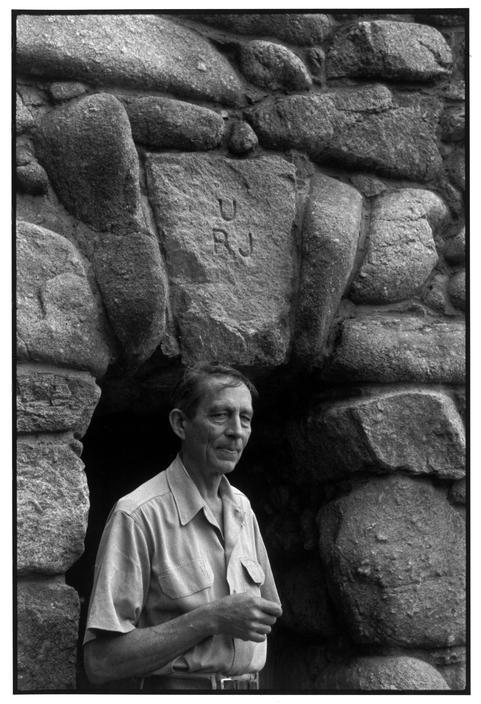
Biografía de ROBINSON JEFFERS

 Hawk Tower and garden gate around The picture is of Tor House, near Carmel, California. Jeffers built the house by hand (i.e. medieval style) over many years. Tor House
Jeffers began construction on Tor House in 1918 and with the aid of a stonemason completed it in 1919. Jeffers named it "Tor" house after the type of ground on which the house was situated, a rocky outcrop known as a "tor". He described the land he chose as the site for the house as being like a "prow and plunging cutwater” of a ship. The Carmel area's influence in Robinson Jeffers' work becomes apparent in his poems such as his work “The Purse Seine,” a poem about the local fishing industry.
He lived out the rest of his life in Tor House, while continuing to add on to it. His routine was to work on his poetry in the mornings and to work on his building projects, such as Hawk Tower and expanding Tor House, in the afternoons.
Construction of Tor House
Robinson Jeffers came to the coast of Carmel in 1914 with his wife Una Jeffers. They decided to remain there; Jeffers bought land and began construction on Tor House out of stones with help from a local contractor. After completion of Hawk Tower, Jeffers continued work on Tor House by adding a dining room. (Originally the house had three bedrooms, a kitchen, living room and a bathroom.) The house was lit by oil lamps and candles until 1949, when electricity was installed.
Hawk Tower
After completing Tor House and learning the art of stonemasonry from the contractor who helped him build it, Jeffers started work on a tower that would take him four years to complete. He began construction in 1920, intending to build the tower for his wife. He named this building “Hawk Tower”, after a hawk that appeared often while he was building the tower, but stopped appearing after he finished construction.
(http://en.wikipedia.org/wiki/Tor_House_and_Hawk_Tower)

Covers of Robinson Jeffers: Poet of California and
Of Una Jeffers: a Memoir, published by Storyline
Press. (photo Jeff Teeter)
ROBINSON JEFFERS TOR HOUSE
This dream home of poet Robinson Jeffers—a cramped stone cottage with low ceilings, minuscule windows, and heavy, somber furnishings—seems all wrong. Why block out that view? Why so small? So dark? Yet five minutes into a tour of Tor House, you find it hard to imagine a more magical dwelling.
In 1914, Jeffers and his wife, Una, settled in Carmel, drawn to the rugged coastline that reminded them of Great Britain. "It was evident that we had come, without knowing it," Jeffers later wrote, "to our inevitable place." That year they bought a large piece of land on a cliff at Carmel Point that encompassed a dramatic outcropping of rock—a tor in Scottish Gaelic. Una wanted a house modeled on a Tudor barn, so the couple hired a stonemason; Jeffers signed on as his apprentice, working until "my fingers had the art to make stone love stone."
Though they entertained a string of distinguished guests at Tor House, from Ansel Adams to Charlie Chaplin, the Jefferses—for philosophical reasons— embraced a strenuously modest lifestyle. They relied for decades on driftwood for heating and candles for light, and their decor was sober and minimal. Now, as then, a few Oriental rugs cover the red-wood floors. A 1905 Steinway baby grand—their lone luxury—dominates a living room the size of a contemporary closet. The whole effect might have been claustrophobic. (...)
Roca y halcón
Aquí hay un símbolo en que
muchas altas y trágicas ideas
miran sus propios ojos.
Esta roca gris, en altura erguida,
sobre el cabo donde el viento marino
no deja al árbol prosperar,
a prueba de mecidas, y marcada
por eras de tormenta: en su cima
un halcón se ha colgado.
Pienso, aquí está tu emblema
para colgar del cielo por venir
no la cruz, no la colmena,
sino este; deslumbrante poder,
o paz oscura; unido pensamiento
al final desinterés;
vida con muerte como en pausa;
los ojos fijos del halcón se ven
casados con la gruesa
mística de la piedra,
cuyo fracaso no puede echar abajo
ningún acaecer de digna forjadura.
(De Poemas Selectos)
Traducción y textos: Juan José Rodríguez
Rock and Hawk Here is a symbol in which
Many high tragic thoughts
Watch their own eyes. This gray rock, standing tall On the headland, where the sea-wind Lets no tree grow, Earthquake-proved, and signatured By ages of storms: on its peak A falcon has perched. I think, here is your emblem To hang in the future sky; Not the cross, not the hive, But this; bright power, dark peace; Fierce consciousness joined with final Disinterestedness; Life with calm death; the falcon’s Realist eyes and act Married to the massive Mysticism of stone, Which failure cannot cast down Nor success make proud. |


| Casa de Robinson Jeffers delante de la bahía de Monterrey |
Documental: Rhapsody & Requiem: The Life of Robinson Jeffers
Otros videos sobre Robinson Jeffers:
 |  |  |  | |





1 comentario:
La torre más allá de la tragedia existe y está dentro de nosotros mismo.
Publicar un comentario